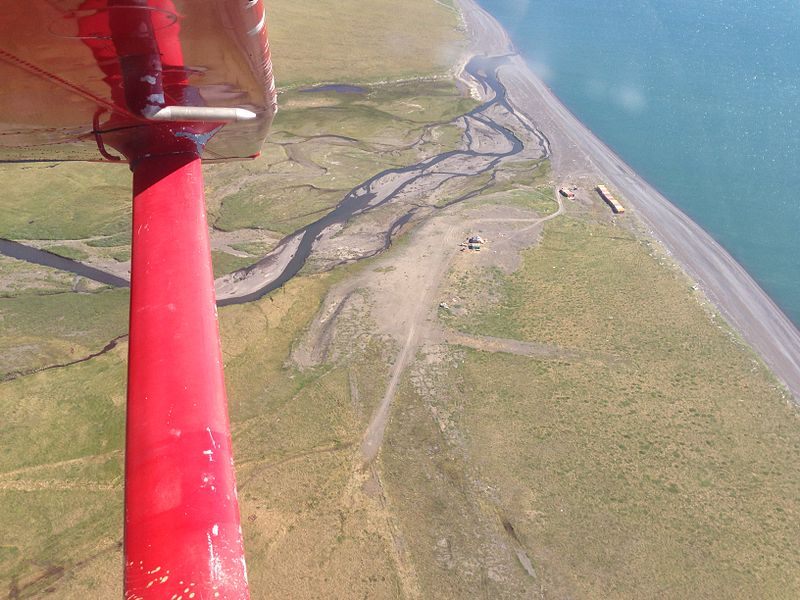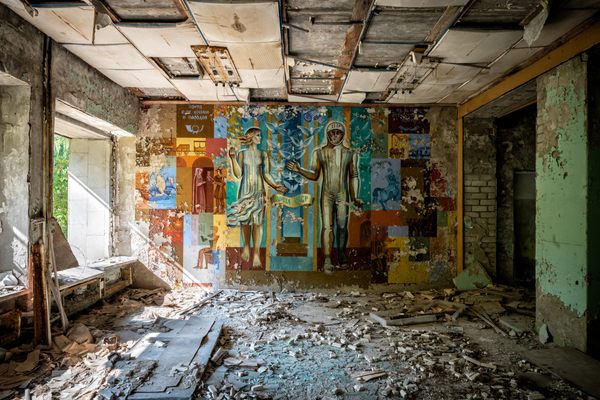Actual 1950s Proposal: Nuke Alaska
 Plans to use five thermonuclear explosions in Cape Thompson, Alaska, for Project Chariot in 1958. (Photo: Public Domain/WikiCommons)
Plans to use five thermonuclear explosions in Cape Thompson, Alaska, for Project Chariot in 1958. (Photo: Public Domain/WikiCommons)
In 1958, the government wanted to nuke Alaska. Called Project Chariot and proposed by physicist Edward Teller, the intent was to use six hydrogen bombs to create a deep-water harbor near Cape Thompson.
As part of Project Plowshare, it was one of the proposed peacetime uses of atomic weapons–the project’s name is a nod to the Biblical edict to beat your swords into plows. In other words, the entire project was the Atomic Energy Commission’s attempt to reuse devastating weapons of war for the public good.
The AEC, which ultimately became the Department of Energy, hoped to harness the “relatively inexpensive energy from nuclear explosions” for two main purposes, according to the DOE’s Executive Summary for Project Plowshare: large-scale excavations and fracking. The nuclear blasts could be used to break up or move huge quantities of rock, or to do a type of fracking wherein the explosion increased the permeability and porosity of rock in order to ramp up natural gas production and create storage areas for natural gas or oil. And, of course, the Russians were invited to watch these marvels of engineering unfold.
An Alaskan deep water harbor was not the only feat of engineering on the list. Perhaps the bombs could punch a hole through the Bristol Mountains, enabling a railway line between California and New Mexico, or perhaps the bombs could be used to instantly widen the Panama Canal. The power of the bomb to reshape the earth nigh instantaneously was too appealing to pass up.
 Aerial shot of Chariot, AK, located near Cape Thompson, the proposed site of an artificial harbor to be created using nuclear explosions. (Photo: Rtones/WikiCommons CC BY-SA 4.0)
Aerial shot of Chariot, AK, located near Cape Thompson, the proposed site of an artificial harbor to be created using nuclear explosions. (Photo: Rtones/WikiCommons CC BY-SA 4.0)
Popular Science wrote of these plans, particularly Project Chariot. In the September 1958 issue, the first year of the project’s existence, the magazine extolled what nuclear weapons could do for the world of tomorrow:
“A-blasts will mine ore now inaccessible, and recover oil locked in shale. Subterranean atomic bombs will drive electric power plants. Underground reservoirs dug with nuclear bombs will make deserts bloom. And the atom’s might power will make child’s play of colossal earth-moving feats, to dig harbors, dredge channels, and build great canals.”
But that article was operating under the belief that atomic bombs had gone clean. While Popular Science trusted the AEC’s claims that they possessed nuclear weapons with reduced fallout or even no fallout at all, the Inuit populations that would be impacted by the project did not.
What was meant to be the first demonstration of nuclear weapons’ peacetime power instead became “possibly the first government project challenged on ecological grounds,” according to a 1989 article from the Bulletin of the Atomic Scientists.
From the start, Alaskans didn’t see the appeal of a deep-water harbor at the proposed Cape Thompson site. The harbor would be frozen for huge swaths of the year, rendering it useless, and it would force the Inuit living 30 miles away at Point Hope to drastically change their way of life. That doesn’t mean they were opposed to nuclear-powered land rearrangement–they just could think of better ways to apply it.
 Edward Teller in 1958, as Director of Lawrence Livermore National Laboratory. (Photo: Public Domain/WikiCommons)
Edward Teller in 1958, as Director of Lawrence Livermore National Laboratory. (Photo: Public Domain/WikiCommons)
While money-minded Alaskans were eager to trust the government, native Alaskans and biologists, both in Alaska and from the AEC itself, were less eager. When the Inupiat of Point Hope met the AEC in 1960 for a town hall meeting, they were ready to defend their village from the proposed blasts. They accepted none of the AEC’s claims that the bombs wouldn’t contaminate their fishing supplies or cause any harm from fallout: they had read about test blasts, such as the 1954 Bravo test in the Bikini Atoll which showered radioactivity over 7,000 square miles of the Pacific. They knew it was ludicrous to believe that their village, as close to ground zero as it was, wouldn’t be harmed in the making of that harbor.
While Teller, the physicist who came up with the idea, was thrilled with the response and eager to hear the alternate plans, he stuck to the Cape Thompson plan all the same. Meanwhile, one of the first environmental studies was being conducted on the area immediately around the proposed blast site. Although biologists at the University of Alaska had demanded the study, it was AEC biologist John N. Wolfe who carried it out. What the study found was incriminating, before even the first test blast: the Inuit and the caribou they ate were already showing heightened radioactivity levels.
It turned out that lichen, the caribou’s food of choice, captured the fallout from the tests around the world particularly well. When the Inuit ate the caribou year after year, it built up in their systems as well. If trace amounts of fallout could be concentrated into their food supply, there was no way a blast merely 30 miles away wouldn’t impact Point Hope. In 1961, the Point Hope Village Council wrote a letter to President Kennedy condemning the plan, asserting their understanding of the risks of radioactive material and emphasizing their “concern about the health of [their] people now and for the future that is coming.”
 Ivy Mike - the codename given to the first test of a full-scale thermonuclear device by the US - at Enewetak Atoll in the Pacific Ocean, on 1 November 1952. (Photo: Public Domain/WikiCommons)
Ivy Mike - the codename given to the first test of a full-scale thermonuclear device by the US - at Enewetak Atoll in the Pacific Ocean, on 1 November 1952. (Photo: Public Domain/WikiCommons)
Project Chariot was quietly shelved. The pushback from local populations and from skeptical scientists across the nation made it too costly. It had also become a redundant experiment. Blasts that had already occurred at the Nevada Test Site could demonstrate anything this test might reveal just as well. The façade of constructing a deep water harbor was abandoned well before the project itself was.
This wasn’t the end of nuclear weapons as proposed construction short-cuts, however. The West Coast must have seemed irresistible to supporters of the H-bomb, for shortly after Project Chariot a plan to use 22 nuclear explosions to carve a highway through California was proposed. Dubbed Project Carryall, the H-bomb blasts would have cut through the Bristol Mountains to make construction of Interstate 40 easier. No town hall meetings were needed this time; technical issues barred the project from getting off the ground, and Teller’s H-bomb again went unused.
 Crater from the 1962 “Sedan” nuclear test, part of Operation Plowshare. The 104 kiloton blast displaced 12 million tons of earth and created a crater 320 feet deep and 1,280 feet wide. (Photo: Public Domain/WikiCommons)
Crater from the 1962 “Sedan” nuclear test, part of Operation Plowshare. The 104 kiloton blast displaced 12 million tons of earth and created a crater 320 feet deep and 1,280 feet wide. (Photo: Public Domain/WikiCommons)
While ultimately nuclear weapons were never used for construction projects, it would be incorrect to say that no bombs were detonated. 27 test blasts were conducted, most of them at the Nevada Test Site, with names that ranged in oddness from Gnome to Klickitat to Templar. Although it was ostensibly intended to reclaim a weapon for peaceful goals, Project Plowshare resulted in much controversy and public outcry, not to mention a huge amount of unnecessary nuclear fallout.
The public did not approve of the government unleashing wave after wave of barely-understood radiation into the environment, and the economic cost couldn’t justify it. “Project Dubious,” as Time satirically dubbed the project in a 1973 article, was finally cancelled in 1977.







Follow us on Twitter to get the latest on the world's hidden wonders.
Like us on Facebook to get the latest on the world's hidden wonders.
Follow us on Twitter Like us on Facebook